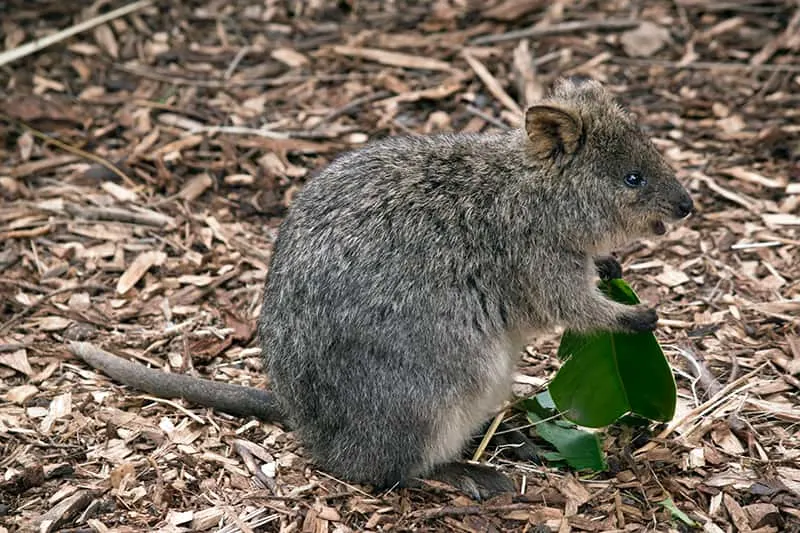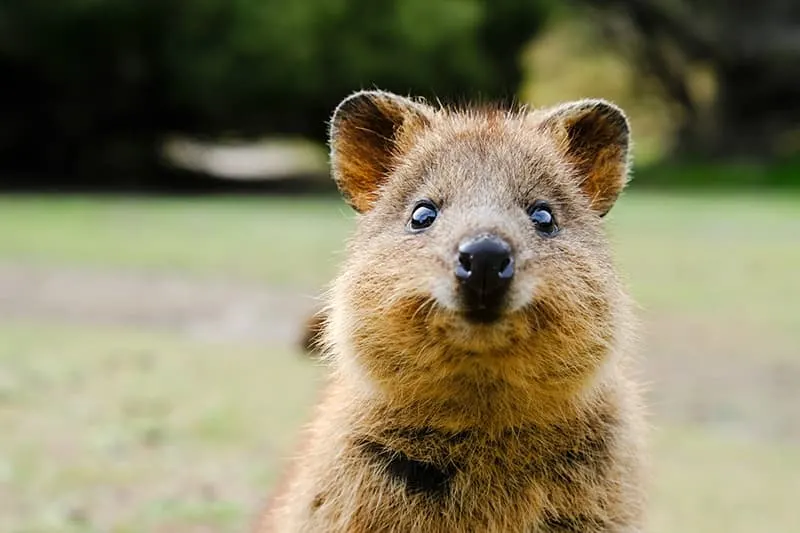Quokkas are marsupials native to Australia that are commonly referred to as the ‘world’s happiest animal’ thanks to its gentle demeanor and smile-like expression.

Physical Description
Quokkas are in the same family as the kangaroo and wallaby. They are about the size of a house cat, averaging 16 to 21 inches in length with males averaging 5 to 10 pounds and females 3 to 8 pounds.
They have fluffy short brown fur, a narrow face, small round ears, black noses and a small jaw with protruding teeth that give quokkas a smiling appearance. Females have a front pouch to carry their young and short, skinny tails. Quokkas have sharp claws and teeth.
Habitat

Quokkas are native to Australia but only a few, specific areas of the country. The first is a protected area called Two Peoples Bay Nature Reserve on the mainland. They can also be found on Rottnest Island and Bald Island. They favor swampy and forested areas but can live in drier climates.
Habits
Quokkas get around by hopping or bounding like their kangaroo relatives. They can also use their hands to move forward.
They live in small groups but are not social with one another. You will not see quokkas playing together or grooming one another. They mainly live in groups for food and safety reasons. They are not usually territorial, with the exception of male quokkas on the mainland.
Quokkas are quite peaceful but if confronted or attacked they will let out a loud shriek. If the shriek does not scare off the attacker, the quokka will defend itself with its sharp claws and teeth.
Diet

Quokkas are herbivores. They eat a variety of leaves, stems, grasses and bark. However, their favorite food is the guichenotia ledifolia, a small, shrub-like plant. They swallow their food whole and then regurgitate it and eat it again. This allows them to better absorb the nutrients in the plants. They can go for a long period of time without food or water, surviving on fat they store in their tail.
Offspring

Quokkas on mainland Australia will mate frequently but will often only have one or two babies each year. Those on Rottnest Island only breed between January and March. Quokka gestation is only one month long.
After that, the baby quokka – called a ‘joey’ – will move into its mother’s pouch. The joey will stay there for several months for warmth, protection, and feeding. After about six months they will leave the pouch and venture off on their own. After a year, they are ready to mate. Male quokkas do not play a part in raising their joey, but they will defend their pregnant mate.
Classification/Taxonomy
Kingdom: Animalia
Phylum: Chordata
Class: Mammalia
Order: Diprotodontia
Family: Macropodidae
Genus: Setonix
Species Name: Setonix Brachyurus
History
Quokkas were first spotted on Rottnest Island in 1658 by Dutch sailor Samuel Volckertzoon but he thought they were species of wild cat. In 1696, Dutch sailor Willem de Vlamingh spotted them again and at first thought they were a type of giant rat. He called the island called Rattennest Island which means “Rat’s Nest” in Dutch. It was later adapted to Rottnest Island.

Quokkas got their name from an adaptation of what the local Nyungar Aboriginal people called the animals. They called them “gwaga” but the European settlers heard it as “quokka.”
Predators
Quokkas had few natural predators in Australia, especially on the islands, aside from Aboriginal people who hunted them for food and fur. Once European settlers arrived, they brought dogs, cats and foxes which began preying on quokkas.
Some believe that when a female quokka is threatened, it will toss its joey at the predator to escape. More accurately, the female quokka will relax their pouch muscles, resulting in the joey dropping from the pouch and distracting the predator, allowing the adult quokka to escape.
Lifespan
Quokkas have a lifespan of about 10 years in the wild and 13-15 years in captivity.

25 unusual facts about Quokkas
- North Americans tend to pronounce quokka as “kwo-ka” but Australians pronounce it “kwah-ka.”
- Quokka selfies have become a very popular trend on social media in recent years. People from all over the world have become enamored with taking selfies with the happy-looking creatures.
- It is against the law in Australia to touch or feed a quokka human food. Breaking the law may result in a heavy fine or even jail time.
- Quokkas are classified as a ‘vulnerable’ species due to a decline in population as a result of habitat loss from human development.
- On Rottnest Island, the quokkas are so comfortable with humans, they tend to wander in to restaurants and shops and have to be chased off.
- Quokkas have been known to follow around humans they take a liking to.
- The quokka’s smile is a result of the shape of their mouth which they often open to stick their tongue out to cool off. This, along with their friendly demeanor, has led to their label as the ‘happiest animal on earth’.
- Quokkas rarely drink water. They extract most of the water they need from the plants they eat.
- Quokkas’ playful behavior with humans is an adaptation to entertain humans in hopes of getting food. This is one of the reasons quokka colonies are often located near homes and tourist sites.
- Conservation efforts in recent years to protect and restore quokka habitats are starting to result in rising populations.
- Quokkas often live near water sources and do have the ability to swim. However, they rarely do.
- Marsupials like quokkas are prone to a condition called lumpy jaw disease (LJD). LJD can infect their bone cartilage and result in pain, distress, starvation and death. LJD can caused by many human foods which is why it is important to never feed a quokka.
- It is illegal for a private citizen to buy, sell, trade, or own a quokka.
- It is estimated there are between 7,500 – 15,000 mature adult quokkas in the wild.
- A wildfire in Western Australia in 2015 destroyed 90% of the local quokka population, driving the number from 500 down to 39.
- In Western Australia, the quokkas like to sleep in Acanthocarpus preissii, a prickly perennial plant that grows on coastal dunes. You can find them sleeping under the spikes.
- Quokkas will often tunnel through tall grasses so they can move about without being seen as they look for food.
- Female quokkas can delay their pregnancy by a process call embryonic diapause. This means they can mate and then delay the development of the fetus until conditions are favorable. It allows the female to conserve energy and resources until their joey has its best chance a survival.
- The mainland Australia quokkas are the most genetically diverse making them especially important to the species long-term survival and well-being.
- Unlike most marsupials, quokkas have color vision.
- The macropod family that quokkas belong to also includes wallabies, wallaroos, pademelons, which are all herbivorous pouched marsupials native only to the Australian continent.
- Quokkas do not use their tails for balance, unlike their kangaroo and wallaby relatives.
- Quokkas are prone to developing muscular dystrophy, a disease where muscles are damaged and weakened, often leading to death.
- On Rottnest Island in the summer and autumn, quokkas have been known to eat small animals such as snails and legless lizards. This is likely because their regular food choices are in short supply.
- When fresh water is in short supply, a quokka may use its sharp claws to dig holes in search of water.
What did you learn about quokkas? Share it in a comment!
Check out these other cool mammals!
